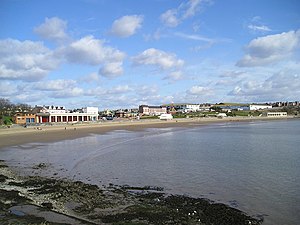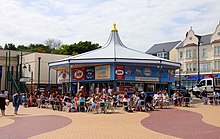Barry Island
| Barry Island | ||
|---|---|---|
| View over Whitmore Bay | ||
| Waters | Bristol Channel | |
| Geographical location | 51 ° 24 ′ N , 3 ° 16 ′ W | |
|
|
||
Barry Island (Welsh: Ynys y Barri) is a district, peninsula and seaside resort as part of the parish of Barry in the Vale of Glamorgan , South Wales . The highest point is about 22 m above sea level . The island is named after a 6th century saint, Saint Baruc . On the coast of the Bristol Channel , the tidal range reaches 15 m, the second largest tide worldwide after the Bay of Fundy . The island was independent from the mainland until 1880 and was only connected to the mainland when the town of Barry expanded significantly during industrialization . In part, this goes back to the opening of the Barry Docks , which were built by the Barry Railway Company . David Davies founded the docks that now span the strait that used to separate the island from the mainland. There was a Butlins Holiday Camp on Barry Island until 1996 . Today, however, it is known for its beach and Barry Island Pleasure Park .
history
prehistory
The area is full of evidence of early human settlement. Mesolithic or Stone Age microlithic flint tools were found at Friars Point on Barry Island and at Wenvoe, and Neolithic stone axes were found at St. Andrews Major . The area was densely forested, so land walks were limited. The first settlers probably came from the sea, some of them from the Iberian Peninsula . The livelihood of the Neolithic settlers, who were taken in by the local population, slowly changed from hunting and gathering to regular agriculture. At St Lythans and Tinkinswood , megalithic beds were built about 6,000 BC , just 4 km and 6 km north of Barry Island, respectively.
Migration of Nations
The population grew slowly over the following centuries. Bronze Age and Iron Age techniques shaped the Celtic cultures. Like most of Wales, Barry Island was settled by Britons known as the Silurians . Five tumuli or cairns at Friars Point have survived from the Bronze Age .
There are no traces of Roman times on Barry Island. The closest localities from this period are in Barry and Llandough . The people adopted Christianity and built a chapel for St. Baruc, a disciple of St. Cadoc . The saint once forgot to take St. Cadoc's books with him on a trip to Flat Holm and was sent back. On the way back he drowned in the Bristol Channel . He was buried on Barry Island. The ruins of the little church can still be seen today on Friars Road . His feast day is September 27th.
When the Vikings raided the area, Barry Island was known as one of their bases around 1087.
Gerallt Gymro
The Norman- Welsche chronicler Gerallt Gymro (1146-1223) described the origin of his family name in The Itinerary of Archbishop Baldwin through Wales (also: The Journey through Wales ). Gerallt Gymro writes:
- "Not far from Caerdyf (sic) is a small island situated near the shore of the Severn, called Barri, from St. Baroc, who formerly lived there, and whose remains are deposited in a chapel overgrown with ivy, having been transferred to a coffin. From hence a noble family, of the maritime parts of South Wales, who owned this island and the adjoining estates, received the name of de Barri. "
- “Not far from Caerdyf is a small island near Severn's shore called Barri, from St. Baroc, who used to live there, and whose remains were laid in a coffin in a chapel overgrown with ivy. Hence a noble family from the coastal area of South Wales who owned this island and the surrounding lands was given the name Barri. ”And he describes the island in detail:
- "It is remarkable that, in a rock near the entrance of the island, there is a small cavity, to which, if the ear is applied, a noise is heard like that of smiths at work, the blowing of bellows, strokes of hammers , grinding of tools, and roaring of furnaces; and it might easily be imagined that such noises, which are continued at the ebb and flow of the tides, were occasioned by the influx of the sea under the cavities of the rocks. Many locals believe it instead to be the ghost of a local hero they call Benedict y Diffoddwr or in English Benedict the Fighter . It is said that when his ship, The Tam Lyn, was overrun by pirating Spaniards he almost single-handedly fought and killed the entire body of pirates even after they had slaughtered his entire crew. He then managed to sail his ship back to port on his own where he was heralded as a hero. They say after many other voyages during which it is rumored he fought off many other pirates (source unverifiable) he eventually died when he was caught in a great storm on the coast, during which his ship was irreparably damaged and sunk to the bottom of the ocean. The locals who believe the legend of Benedict claim that their defender still lingers in the rocky areas on the South coast, protecting the inhabitants from foreign invaders. "
It is noteworthy that in a rock at the landing site of the island there is a small cavity, in which, if you hold your ear to it, you can hear sounds like blacksmiths at work, the hissing of the bellows, the beating of the hammers, grinding listen to the tools and roar of the stove; and it is easy to imagine that such noise, which continues during the ebb and flow of the tide, is caused by the flow of the sea under the cavities of the rocks. However, many locals believe it is the spirit of a local hero whom they call Benedict y Diffoddwr (Benedict the Fighter). It is said that when his ship, the Tam Lyn , was attacked by Spanish pirates, he fought and killed the entire pirate crew almost with one hand, even though they had already murdered his crew. He managed to steer his ship back into the harbor, where he was celebrated as a hero. It is said that after many more voyages, rumored to have fought many other pirates, he finally died when he succumbed to a great storm on the coast during which his ship was completely destroyed and sank to the bottom of the sea. Locals who believe this legend claim that its protector still prowls the rocky areas of the coast, protecting residents from attackers.
The 1908 edition of Everyman's Library contains a brief description of Barry Island by Benedictine Hugh Paulinus de Cressy (~ 1605–1674): “Barri Island is situated on the coast of Glamorganshire; and, according to Cressy, took its name from St. Baruc, the hermit, who resided, and was buried there. The Barrys in Ireland, as well as the family of Giraldus, who were lords of it, are said to have derived their names from this island. John Leland , in speaking of this island, says, 'The passage into Barrey isle at ful se is a flite shot over, as much as the Tamise is above the bridge. At low water, there is a broken cause to go over, or els over the shalow streamelet of Barrey-brook on the sands. The isle is about a mile in cumpace, and hath very good corne, grasse, and sum wood; the ferme of it worth aio a yere. There ys no dwelling in the isle, but there is in the middle of it a fair little chapel of St. Barrok, where much pilgrimage was usid. '"
Barri Island is on the Glemorganshire coast and, according to Cressy, takes its name from St. Baruc, the hermit who lived and was buried there. The Barrys in Ireland, as well as the Giraldus family, who were masters there, are said to take their name from the island. John Leland speaks of the island and says: The passage to Barry Island is an arrow shot when the tide is high, as is the Tamise (Thames) above the bridge. At low tide there is a bumpy sound to go over it, or over the shallow stream of Barrey-Brook over the sand. The island is about a mile in circumference, and has very good grain, grass, and wood; the farmland is worth ~~. There are no houses on the island, but in the middle there is a beautiful little chapel of St. Barrock, where there has been a lot of pilgrimage. Ernest Rhys, the editor, added in 1908: “The 'beautiful little chapel' has disappeared and Barry Island has now been connected to the mainland since the construction of the great dock, has houses, and has an estimated capital value of £ 250,000 . "
Modern Times
Until 1896, the only access to the island was either on foot over sand and mud at low tide, or at high tide with the paddle steamers of the Yellow Funnel Line . Then a pier was built that connected the island to the mainland. The 228.6 m (250 yards) long construction is part of the Barry Island railway station and thus the terminus of the Vale of Glamorgan Line to Cardiff. The route heads northeast for approximately 14 km (9 mi). Since then, various tourist attractions have been built on the island, and by 1934 the amusement park had more than 400,000 visitors on August Bank Holiday Week .
The ashes of British serial killer Frederick West were scattered along the Barry Island coast in 1995. And the rollerblade champion from Barry Rich Taylor died after a skate accident on August 2, 2004 on Barry Street .
On 25 July 2008 that sent Scott Mills show on BBC Radio 1 , a special edition of its Summer Events with the recurring "Barryoke" theme. The song Smooth Barry was played as an allusion to Smooth Criminal by Michael Jackson .
The Wales Coast Path opened in 2012 and loops around Barry Island before continuing west towards Llantwit Major .
Holiday Camp
Butlins Barry Island was a holiday camp that operated on the island from 1966 to 1996. During this time it was even known as The Barry Island Resort seaside resort for nine years .
Popular culture
The Holiday Camp was the filming location for several episodes of the Doctor Who series (as "Shangri-La" holiday camp in Delta and the Bannermen , The Empty Child (2005) and The Doctor Dances as a backdrop for a bombed-out London street from 1941.).
The BBC series Gavin & Stacey is partly acting in Barry and is then produced there.
The island was also the setting for Pleasure Park on ITV Wales ( It's My Shout shorts) and The Mad Woman in the Attic (third season of Sarah Jane Adventures ), as well as the third, fourth and fifth episodes of Being Human and the film Submarine . In Silvery's debut album (2008), the song Warship Class mentions Barry Island.
Individual evidence
- ^ Making a splash: the Severn Bore . In: Making a splash: the Severn Bore . BBC. 2004. Archived from the original on September 15, 2007. Retrieved on September 9, 2008.
- ^ Severn Estuary . Joint Nature Conservation Committee. 2001. Retrieved September 9, 2008.
- ^ G Dowell: Archeology in Wales Vol. 11, pp. 10-11 . Council for British Archeology, 1971.
- ↑ HN Savory: Axes of Pembrokeshire Stone from Glamorganshire Volume XIII pp. 245-6 . Board of Celtic Studies, 1948-50.
- ↑ Genes link Celts to Basques . In: BBC News website . BBC. April 3, 2001. Retrieved August 5, 2008.
- ↑ St Lythans Chambered Long Cairn, Maesyfelin; Gwal-y-Filiast . In: The Royal Commission on the Ancient and Historical Monuments of Wales website . Royal Commission on the Ancient and Historical Monuments of Wales. July 26, 2007. Archived from the original on December 23, 2012. Info: The archive link was automatically inserted and not yet checked. Please check the original and archive link according to the instructions and then remove this notice. Retrieved August 8, 2008.
- ↑ FRIAR'S POINT MOUND (CAIRN III) . In: The Royal Commission on the Ancient and Historical Monuments of Wales website . Royal Commission on the Ancient and Historical Monuments of Wales. July 26, 2007. Archived from the original on December 23, 2012. Info: The archive link was automatically inserted and not yet checked. Please check the original and archive link according to the instructions and then remove this notice. Retrieved September 11, 2008.
- ^ Times Past . Barry Town Council. Archived from the original on July 21, 2006. Info: The archive link was inserted automatically and has not yet been checked. Please check the original and archive link according to the instructions and then remove this notice. Retrieved April 10, 2007.
- ↑ a b c d BARRY ISLAND, WELL SITE (PDF) In: The Itinerary through Wales and The Description of Wales , by Giraldus Cambrensis, Everyman's Library, Edited by Ernest Rhys, with an Introduction by W. Llewelyn Williams, January 1908 . University of Toronto. 2008. Retrieved September 14, 2008.
- ↑ BARRY ISLAND, WELL SITE . In: The Royal Commission on the Ancient and Historical Monuments of Wales website . The Royal Commission on the Ancient and Historical Monuments of Wales. 2008. Accessed on September 14, 2008. ( Page no longer available , search in web archives ) Info: The link was automatically marked as defective. Please check the link according to the instructions and then remove this notice.
- ↑ There's more to our Barry Island than a TV comedy . Media Wales. Retrieved August 3, 2013.
- ↑ BBC Summer 2008 - Barry Island . BBC . Archived from the original on August 31, 2008. Retrieved July 25, 2008.
- ↑ Barry Island ( Memento of the original from July 31, 2012 in the Internet Archive ) Info: The archive link was inserted automatically and has not yet been checked. Please check the original and archive link according to the instructions and then remove this notice. , Dai Davis, BarryIsland.org.
Web links
- British geographic information system









